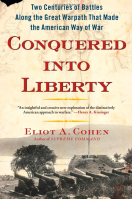
Long-ago war stories...
Eliot Cohen is one of those Washington, D.C., polymaths who, when he’s not professing at the Johns Hopkins School of Advanced International Studies, is putting together the Gulf War Air Power Survey or the already-classic Supreme Command: Soldiers, Statesmen, and Leadership in Wartime. In his spare time, he writes books that are – dare we say it? – fun to read (not to say that the GWAPS wasn’t a hoot, in its own way).
His latest is Conquered into Liberty – the lengthy struggle among the British, French, Americans, Canadians, and Indians – that helped forge American geopolitics and the nation’s military culture. They fought over that long-ago keystone of North America – that corridor running from Albany to Montreal, dominated by the Champlain valley — and known to Native Americans as the Great Warpath. Battleland chatted via email with Cohen about his pre-revolutionary book:
Why did you write Conquered into Liberty?
The book deals with battles along the “Great Warpath” from Albany to Montreal over two hundred years. It is an area that had fascinated me as a boy: in recent years, though, I began to conclude that that period of chronic warfare was deeply important for understanding the American way of war.
What does the title mean?
The Continental Congress ordered the invasion of Canada in 1775, before the United States had even declared its independence from Great Britain. In advance of a two pronged invasion – one north along the Great Warpath, one through the woods of Maine – the Congress had a subversive letter addressed to the French residents of Canada spread about by American agents. It begins, “You have been conquered into liberty.” Right there you have one of the enduring themes of American strategy: the notion that one can, in fact, conquer an enemy into liberty. Its what we did to Germany and Japan during World War II, after all – and, some would say that we are still at it.
Was Canada really an enemy of the U.S.?
It might be more correct to say that the rulers of Canada – France first, and then Britain – were. The animosity Americans felt towards French Canada until its conquest in 1759 was implacable, largely as a result of the ferocity of frontier warfare. Once Britain resolved its outstanding issues with the United States in 1871, American relations with Canada were transformed, and despite the paper plans that were still drafted by general staffs, I really do not think war was in the cards ever again. But that should not cause us to forget the deadly seriousness of the struggles. Americans often fail to realize how frequently they invaded, or thought seriously about invading Canada; a third Anglo-American war (the Revolution and the War of 1812 being the first two) was very much in the cards through the Civil War, and Canada would have been the main battlefield.

Eliot Cohen
What did writing it teach you?
Of course, I learned a great deal of detail about people, places, and events, of course. But the most interesting thing came from when I wrote it. From 2007 to 2009 I was Counselor of the Department of State, serving as Condoleezza Rice’s senior foreign policy adviser, with particular focus on issues of war and peace. In government I learned a number of things that informed the writing of the book – just how murky the future looks when you are making policy, the role of personalities and individual quirks in how decisions get made, the virtual reality, as it were, of events that you are virtually certain will happen, but do not. I try to weave that knowledge into the book.
Why should non-history buffs read it?
Often people shy away from history because they think of it as dusty stuff, dreary and not particularly relevant to life as they know it. It is anything but, and I have written the book in such a way, I hope, as to make these events and the personalities who shape them come alive. Take Benedict Arnold, for example, whose genius as a commander I describe as he builds a fleet in the wilderness and takes on the Royal Navy, or less well known, but no less interesting, La Corne St. Luc, a French leader of Indians whose adventures include a 1500 mile trek to Quebec in the winter after being shipwrecked off what is now Cape Breton Island. And having walked all the ground I write about (including snowshoeing the site of the Battle on Snowshoes), I have given readers a real sense for the ground, as it is today, and as it was then.
What lessons can be gleaned from the Great Warpath for today’s national security challenges?
The last chapter of the book is entitled “Legacies,” and that’s really the way to think about it. I have always been wary of pat lessons – history is about the diversity and particularity of circumstances. But in the same way that self-knowledge is a big help to an individual, so too is knowledge of this country’s history, including its military history. And the Great Warpath is where it started: the Rangers that conduct midnight raids in Afghanistan and Iraq were formed in upstate New York in the 1750’s; and for better or worse, conquering into liberty is what we seem to be attempting in both places.


